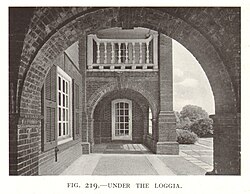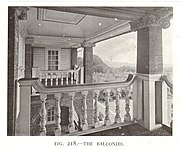Monkton House, West Dean, West Sussex is an English country house designed in 1902 by Edwin Lutyens for Willie James. It was extensively remodelled for his son, Edward James, in the 1930s. Working with Christopher Nicholson and Hugh Casson, and assisted by Salvador Dalí, James constructed what has been called "the only complete Surrealist house ever created in Britain". The collection of Surrealist art and furniture which James assembled at the house, much of it by Dalí himself, was "one of the largest and most important in the world". A private residence, Monkton is a Grade II listed building.
| Monkton House | |
|---|---|
 "the only complete Surrealist house ever created in Britain" | |
| Type | House |
| Location | West Dean, West Sussex |
| Coordinates | 50°57′00″N 0°49′09″W / 50.94999°N 0.81924°W |
| Built | 1902-03. Surrealist remodelling c. 1930 by Christopher Nicholson, Hugh Casson and Salvador Dalí for Edward James |
| Architect | Edwin Lutyens |
| Governing body | Privately owned |
Listed Building – Grade II | |
| Official name | Monkton House |
| Designated | 20 September 1985 |
| Reference no. | 1026127 |
History
Willie James (1854–1912) was the third son of Daniel James (1801–1876), an American-born businessman who had made his fortune as a founder of the trading firm Phelps Dodge and moved to Liverpool to manage the English end of the firm's operations.[1] Willie eschewed a business career, and following a youth spent travelling, established himself as a country gentleman, purchasing the West Dean estate in 1891. In 1902 he commissioned Edwin Lutyens to design Monkton House as a shooting lodge. The house acted as a trianon to the larger property.[a][5] James' wife, Mrs Willie James was a noted Edwardian hostess and the Prince of Wales was a regular visitor.[b][7]
Willie James died in 1912, and was succeeded by his son Edward, then a boy of five. Marrying, and subsequently divorcing, the dancer Tilly Losch, the bisexual James' greatest passion was Surrealism.[8] An early supporter of Salvador Dalí, he engaged Christopher Nicholson and Hugh Casson to redesign Monkton and employed Dalí to decorate the interiors.[9] Designed in extreme reaction to Lutyens' "cottage-y" style,[10] Monkton has been described as "the only complete Surrealist house ever created in Britain".[11] James stopped living at Monkton in the 1930s, returning for only brief visits, and the interior was left largely untouched.[12] In later years James used the house to store the contents of other houses he had acquired.[13]
James established the Edward James Foundation in 1964 and founded West Dean College in 1971.[14] The college teaches courses in historic crafts and preservation. James sold some of his surrealist paintings to fund the college.[c][14] On James' death in 1984, Monkton House passed to the Edward James Foundation.[14]
Sale
In 1986 the foundation announced it intended to sell the house and its contents. The foundation’s trustees insisted that the sale was financially necessary,[15] Christopher Gibbs saying that they "[couldn't] go into an open ended liability running a museum of surrealism".[15] A campaign, 'The Monkton Appeal', was launched by The Thirties Society and Save Britain's Heritage to purchase both for the nation, with the aim of raising £1.6 million (equivalent to £5,921,660 in 2023) by June 1986.[16][17] The two groups secured a commitment from English Heritage to run the house and open it to the public if £650,000 could be found for the house and an additional £950,000 to purchase its contents.[12] The chairman of English Heritage, Lord Montagu of Beaulieu, said that he was prepared for his body to run the house at an estimated cost of £50,000 a year provided the £1.6 million purchase cost had already been raised.[15] In April the National Heritage Memorial Fund declined to make any contribution to the purchase price.[18] This was a major blow to the campaign, which had expected the fund to assist them.[18] The fund's director, Brian Lang, considered that the public benefit gained from saving Monkton was "a bit marginal".[19]
Some of the leading architectural historians of the day, including Clive Aslet, Mark Girouard, and Gavin Stamp, strongly disagreed and vocally opposed the sale. Girouard described the creation of the house as "a dream expressed in three dimensions".[12] Aslet said that it was difficult for outside organisations to raise the money to buy the house and its contents as the sale had been "pushed so quickly" by the foundation.[12] Stamp mourned the loss: "had this ensemble not been broken up, Britain could now boast the finest collection of Surrealist art in the world".[20] The architect Hugh Casson, who had worked on the house in the 1930s, was also opposed.[18] Conversely, the architectural historian John Cornforth considered that Monkton did not merit saving and his views were perceived as particularly influential in the failure of the campaign.[d][21]
A five-day auction of the contents of Monkton, described as "The Edward James Collection", was held by Christie's in June 1986 on the lawn of West Dean College. It raised £4,516,544 (equivalent to £16,715,899 in 2023).[22][23][24] The prints, drawings and paintings raised almost £1 million.[22] A 1936 painting by Max Ernst went for £64,800 despite having failed to sell at auction twice in previous years.[22] The proceeds went to the endowment fund of West Dean College.[22]
Monkton House itself was put on the market, with 66 acres of woodland and a cottage, for £750,000 in June 1986 (equivalent to £2,775,778 in 2023).[22] It was bought by Simon Draper, the former chairman of Virgin Records.[25] The house came with an aviary and James's collection of pheasants. Draper had unhappy memories of pheasants from his schooldays in South Africa, and asked the Edward James Foundation to take them away. The birds were re-homed at Beale Wildlife Park in Berkshire.[25] Draper subsequently changed his mind and decided to re-establish the pheasant population at Monkton, and contacted the World Pheasant Association in Shepperton who assisted him with starting a breeding programme.[25] In 1997 Draper's publishing company, Palawan Press, published The Atlas of Rare Pheasants in an edition of 48, illustrated by Timothy Greenwood.[25]
Monkton was featured in Country Life magazine in their 12 September 1985 issue.[4] The house was profiled by George Melly in Monkton – A Surrealist Dream, broadcast on Channel 4 in May 1986.[26] The head gardener for 15 years was Ivan Hicks,[27] who also worked with James on the creation of his gardens in Italy and Las Pozas in Mexico.[27]
Architecture and interior description
Monkton House has been listed Grade II on the National Heritage List for England since September 1985.[4] Lutyens designed the building in brick, but during Edward James' renovations, this was rendered in purple stucco at the suggestion of Dalí.[28] Of two storeys, with multiple balconies, the exterior exhibits a number of unusual, Dalí-esque features, such as the drain pipes which are supported by palm tree columns.[4] An external clock at the house tells the days of the week and an external chimney is shaped like a tombstone.[26] Moulded draperies resembling billowing, drying linen hang from the upper windows.[26]
The interior decoration was ordered by James and Norris Wakefield.[28] It was noted for its extensive use of textiles; the walls of the drawing room are covered with a quilted fabric.[28] The Map Room featured a bed upholstered in blue silk,[28] which was sold at auction at Phillips in April 2018.[28] A glass panel in the centre of the ceiling of the map room was backlit with stars that were "positioned to represent the moment of James' birth".[28] One bathroom was themed around fish.[28] James's own bed was a replica of Napoleon's hearse.[e][13] A poem written and illustrated by James as an obituary for his friend Evelyn Waugh hung on the back staircase of the house.[13] James's biographer Philip Purser described the cumulative effect as resembling "a mad potentate's private brothel".[14]
The interior included many pieces by Dalí, in particular his Mae West Lips Sofa,[f][33] his Lobster Telephone[34] and his Champagne Standard Lamps.[g][11] Other pieces included the Drowning Hands Chair,[h][14] and the Pink Glove Tea Service.[38][39] They were mainly commissioned from the designers Green & Abbott, who worked with Syrie Maugham on their realisation.[23] A staircase carpet originally at the house was embroidered with the outline of the wet footprints made by Tilly Losch when she ran naked from a bathroom to her bedroom. Following their divorce, James moved the carpet to West Dean (where it remains), and replaced it with one embroidered with the footprints of his dog, whom James maintained had exhibited greater loyalty.[i][41][42] The Victoria and Albert Museum, which ultimately acquired one of the pairs of lamps, and one of the Mae West Lips sofas,[43] described James as a "key figure in the promotion and international recognition of Surrealism", and considered his collection, much of which was once held at Monkton, "one of the largest and most important in the world".[44]
Gallery
- The entrance front
- The garden front
- Balconies
Footnotes
References
Sources
- Charman, George (2014). Artichoke House (PDF). London: Silent Grid. ISBN 978-0-993-02310-1.
External links






